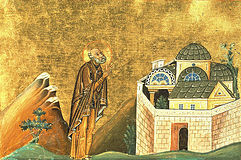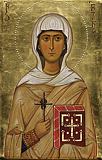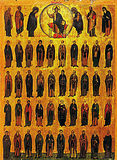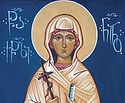

| Previous day | Next day |
| Old Style
January 14
|
Sunday |
New Style
January 27
|
| 35th Sunday after Pentecost. Tone 2. | No fast.
|
![]() Apodosis of the Theophany.
Apodosis of the Theophany. ![]() The Holy Fathers slain at Sinai and Raithu: Isaiah, Sabbas, Moses and his disciple Moses, Jeremiah, Paul, Adam, Sergius, Domnus, Proclus, Hypatius, Isaac, Macarius, Mark, Benjamin, Eusebius, Elias, and others (4th c.-5th c.).
The Holy Fathers slain at Sinai and Raithu: Isaiah, Sabbas, Moses and his disciple Moses, Jeremiah, Paul, Adam, Sergius, Domnus, Proclus, Hypatius, Isaac, Macarius, Mark, Benjamin, Eusebius, Elias, and others (4th c.-5th c.). ![]() St. Nina (Nino), Equal-to-the-Apostles, enlightener of Georgia (335).
St. Nina (Nino), Equal-to-the-Apostles, enlightener of Georgia (335).
St. Joseph Analytinus of Raithu Monastery (4th c.). St. Theodulus, son of St. Nilus of Sinai (5th c.). St. Stephen, abbot of Chenolakkos Monastery near Chalcedon (8th c.). St. Acacius, bishop of Tver (1567). St. Meletius, bishop of Ryazan, missionary to Yakutia (1900).
New Hiero-confessor John (Kevroletin), hieroschemamonk, of Verkhoturye (1961). New Martyrs slain at Raithu Monastery near Kazan: hieromonks Joseph, Anthony, Barlaam, Job, and Sergius, and novice Peter (1930).
St. Kentigern (Mungo), first bishop of Strathclyde (Glasgow), Scotland (612). St. Fulgentius, bishop of Ecija, Spain (632). St. Sava I, enlightener and first archbishop of Serbia (1235).
Repose of Nicholas Motovilov (1879), disciple of St. Seraphim of Sarov, and Hieromonk Cosmas, missionary to Zaire (1989).
Articles
 St. Joseph Analytinus of RaithuSaint Joseph Analytinus of Raithu was a strict ascetic |
 Venerable Stephen the Abbot of Khenolakkos Monastery, Near ChalcedonSaint Stephen lived during the eighth century, and was born into a family in Cappadocia, who raised him in great piety. |











